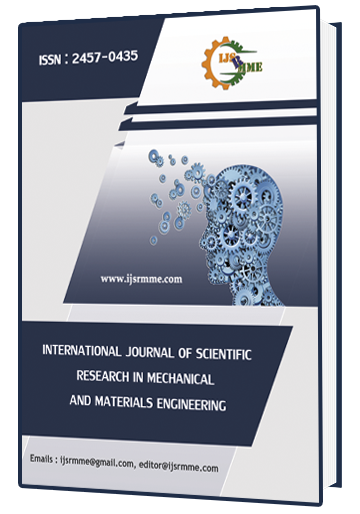Mechanical and Thermal Properties of Nano-Sio2 Epoxy Coir Fiber Reinforced Composites with Conventional Epoxy-Based Composites
DOI:
https://doi.org/10.32628/IJSRMME25942Abstract
Comprehensive analysis of nano-SiO2-reinforced epoxy composites and compared them with commonly used coir fabric. For both static and dynamic applications, coir fabric composites were considered as suitable material due to their strength and biodegradability. In this research, 15 nm SiO2 nano powder was used as a filler. Several composite laminates with different filler concentrations of 2%, 3%, and 5% SiO2 by weight of the epoxy resin were fabricated using hand lay-up method (LY556). Various testing methods, including tensile testing, impact testing, wear testing, moisture absorption testing, and thermogravimetric analysis (TGA), were employed to evaluate the properties of the final composite. The results indicated that the mechanical and thermal characteristics of the produced composite were significantly influenced by the filler material.
References
Abdi, A., Farsani, R. E., and Khosravi, H. (2018). An investigation into the mechanical characteristics of epoxy-based composites reinforced with basalt fibers and enhanced with surface-treated calcium carbonate (CaCO₃) nanoparticles. Fibres and Polymers, 19, 635–640. DOI: https://doi.org/10.1007/s12221-018-7755-x
Ahmed, K. S., and Vijayarangan, S. (2007). Experimental analysis of isothalic polyester composites reinforced with woven coir fabric. Journal of Applied Polymer Science, 104, 2650–2662. DOI: https://doi.org/10.1002/app.25652
Ahmed, K. S., Mallinatha, V., and Amith, S. J. (2011). Influence of ceramic particulate fillers on the mechanical behavior of epoxy composites reinforced with woven coir fabric. Journal of Reinforced Plastics and Composites, 30, 1315–1326. DOI: https://doi.org/10.1177/0731684411420606
Ahmed, K. S., Khalid, S. S., Mallinatha, V., and Kumar, S. A. (2012). Investigation of dry sliding wear characteristics in coir/epoxy composites infused with SiC and Al₂O₃ ceramic fillers. Materials and Design, 36, 306–315.Al-Mosawi, A. I., Al-Maamori, M. H., and Wetwet, Z. A. (2012). Mechanical performance evaluation of composites reinforced with a hybrid combination of natural and synthetic fibers. Academic Research International, 3, 108–112. DOI: https://doi.org/10.1016/j.matdes.2011.11.010
Alshammari, B. A., Saba, N., Alotaibi, M. D., Alotibi, M. F., Jawaid, M., and Alothman, O. Y. (2019). Assessment of the mechanical, physical, and structural characteristics of epoxy-based composites incorporating various date palm fillers. Materials, 12, 1–17. DOI: https://doi.org/10.3390/ma12132145
An, L., Zhang, D., Zhang, L., and Feng, G. (2019). Influence of particle size on the mechanical behavior of assembled nanoparticle structures. Nanoscale, 11, 9563–9573. DOI: https://doi.org/10.1039/C9NR01082C
Anaidhuno, U. P., Edelugo, S. O., and Nwobi-Okoye, C. C. (2017). Analysis of mechanical behavior and failure simulation of a sisal/coir hybrid polymer composite used in automotive chassis panels. Evaluation, 7, 56–64.
Manral, A., and Bajpai, P. K. (2018). IOP Conference Series: Materials Science and Engineering, 455, 012115. DOI: https://doi.org/10.1088/1757-899X/455/1/012115





